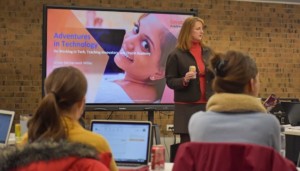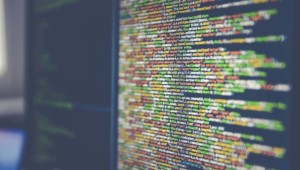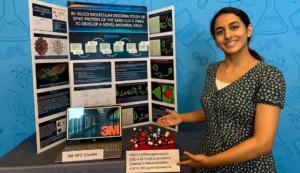To Improve STEM Education, We Must Democratize It
Key Points
-
Being introduced to a democratic STEM teaching framework empowered me to welcome feedback from my students, iterate my approach to teaching to better fit their needs, and create a more equitable learning space.
-
I became invested in elevating my students’ voices, sharing authority in the classroom, and centering my teaching around developing their ability to think about STEM critically.

By: Kelly Houston
The New York City Teaching Fellows program was specifically tailored towards folks who wanted to work in urban, underserved schools. At the time of my acceptance into the program, I had never even been to New York before. To say I felt unprepared to handle the social inequalities and systematic racism facing my Crown Heights, Brooklyn, students is an understatement. I was not confident that I could do the job. Gang violence, a lack of resources, and high teacher turnover plagued our school.
In fact, schools that are in the top quartile of serving students of color see a 90% higher turnover rate among math and science teachers than the quartile of schools serving the most white students. At Title I schools, turnover rates for math and science teachers are nearly 70% higher than at non-Title I schools. So why aren’t there more qualified teachers in these schools? It’s complicated, but broadly speaking, teaching these subjects in these schools can be really tough.
STEM Teaching Challenges
In my first years as a teacher, I thought it was my job to teach the aspects of science, so I spent hours scouring the internet for ideas to engage my students. When students struggled, I would comfort myself by maintaining an unhealthy narrative that “they didn’t come to class” or “they didn’t do their homework” so it wasn’t my fault if they weren’t ”getting it.” But in fact it was me who wasn’t “getting it.”
I needed to take a step back and have some perspective. Why didn’t they come to class? Maybe they had to stay home and watch their sick younger sibling so their mom could go to work. Maybe they didn’t do their homework because they went to work themselves to help pay the bills at home.
I needed to take a step back and have some perspective.
Kelly Houston
I grew up in a suburban white community. I needed to take the time to understand the wider system I was working in and my students were living in and how my identity as a white woman in a classroom full of students of color played a role. I realized my job was bigger than just teaching science.
A key part of that job was trying to literally connect with families. Some of my students were undocumented, so connecting with their parents could prove difficult. Since we were part of the small school movement, oftentimes our teachers were the only subject teacher for their grade. There was not a lot of professional development available outside of the school for STEM teachers that was available or affordable, and the professional development time within the school was spent on the social emotional aspects of our student population, leaving little room to discuss pedagogy.
A lack of ongoing professional development and isolation from colleagues teaching similar subjects has many negative implications, particularly for teacher retention. An inability to collaborate with colleagues is a big factor in job satisfaction, especially among STEM teachers.
Finding Community, Building Equity
When I was accepted as a STEM Ed Innovators fellow as a third-year teacher, I was relieved. Connecting to a larger cohort of educators who were experiencing the same challenges gave me the sense of community I was desperately missing. I wasn’t the only one struggling to engage students. We were all learners and now we had a safe, supportive space to share our common struggles, ideas, failures and successes.
Now I felt empowered to challenge myself in how I was teaching. Being introduced to a democratic STEM teaching framework empowered me to welcome feedback from my students, iterate my approach to teaching to better fit their needs, and create a more equitable learning space. I became invested in elevating my students’ voices, sharing authority in the classroom, and centering my teaching around developing their ability to think about STEM critically.
Under this model, students are not vessels to be filled with knowledge, but co-designers and co-authors of their own education. Their funds of knowledge and interests shape the classroom environment and curriculum choices.
It wasn’t until I adopted this approach that I really fell in love with teaching.The power dynamic shifted, and suddenly I was in constant conversation with my students. Together we created a classroom where everyone felt included and important. We continued to push our way through the state mandated curriculum, but now there was room to make the science relevant to their lives, their community, and possibly their future.
A Model for Success
Eighteen years into my teaching career, I now teach on Cape Cod at an International Baccalaureate School. The curriculum is rigid, but I continue to teach democratically and students have a lot of choice in how they want to demonstrate their mastery. Here are a few ways I have refined my teaching:
- Create spaces for open discussions rooted in shared classroom agreements.
- Provide surveys as a way to check in on a social-emotional level.
- Find class time to co-create rubrics and decide which topics to lean into as a group.
- Spend time reflecting on lessons and utilize the feedback I get from students.
I also try to model this type of teaching to my colleagues. Here are ways I encourage those who are interested to start small:
- Build trust and welcome genuine relationships with all students.
- Encourage students to find ways to advocate for their needs and seek opportunities for open communication with teachers.
- Choose workshops that align with beliefs in a democratic classroom.
- Continue to look for opportunities outside of school including attending conferences, listening to podcasts, and collaborating with colleagues.
I have learned that there is power when we start seeing learners as future scientists, engineers, and mathematicians. We enter teaching not because we want to help students do better on standardized tests, but because we love to guide the learning and help students see themselves in innovative careers.
Kelly Houston began her teaching career in the Peace Corps serving in Malawi, Africa and taught for ten years in Brooklyn, NY before moving to Cape Cod, MA where she teaches Biology at an International Baccalaureate School. During her career she has served as a curriculum coach, team leader, and science department chair. Currently she is a mentor fellow in the STEM Ed Innovators Program, where she also serves as the Director of Operations. Reach her at kelly.h@stemedinnovators.org.





0 Comments
Leave a Comment
Your email address will not be published. All fields are required.